For any guitarist, the journey to perfect sound begins with tuning. It might not be the flashiest piece of gear, but a reliable tuner is undeniably the cornerstone of your musical setup. Whether you’re just starting your guitar journey or you’re a seasoned pro, owning one of the Best Guitar Tuner Pedals is essential. It’s the first pedal in your chain, the first step in any recording process, and your constant companion for practice and performance. Unless you possess the rare gift of perfect pitch, a top-quality guitar tuner pedal is indispensable.
At guitarplayers.net, our team of seasoned content creators are also active guitarists with years of experience in recording studios, live stages, and practice rooms. We’ve encountered and tested countless guitar tuners across the spectrum. Many of the models featured here have been personally reviewed, rigorously tested under diverse conditions to meet the high standards we expect from our own equipment. We understand that a great tuner pedal must be robust, intuitive to operate, and equipped with a crystal-clear display that remains easily visible in any lighting scenario, from dimly lit stages to bright sunlight.
In 2024, the market presents an overwhelming array of guitar tuner pedals. To simplify your choice, we’ve curated a selection of our top recommendations, categorized to address various needs and preferences. Whether you’re a bassist struggling with tuners that can’t accurately register lower frequencies, or a guitar technician seeking the ultimate tuner for precise intonation adjustments, you’ll discover an ideal solution within our guide. If you’re new to the world of guitar tuner pedals, be sure to explore our comprehensive buying advice section further down, where we address frequently asked questions to arm you with the knowledge to make an informed decision.
Best Guitar Tuner Pedals: Top Picks
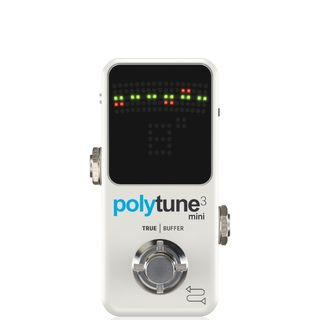 Best guitar tuners: TC Electronic PolyTune 3 Mini
Best guitar tuners: TC Electronic PolyTune 3 Mini
Best Overall Guitar Tuner Pedal: TC Electronic PolyTune 3 Mini
Its compact size, exceptional tuning precision, and polyphonic tuning capability, allowing you to check the tuning of all strings simultaneously, make the TC Electronic PolyTune 3 Mini an outstanding choice for any guitar player seeking a pedal tuner.
Best Pedal Guitar Tuner for Stage Reliability: Boss TU-3 Chromatic Tuner
No compilation of guitar tuner pedals would be complete without the iconic Boss TU-3. A familiar sight on professional pedalboards worldwide, the TU-3’s legendary durability and unwavering reliability solidify its position as a top pedal tuner.
Best Clip-On Tuner for Versatility: D’Addario NS Micro
The D’Addario NS Micro Universal clip-on tuner stands out with its unobtrusive yet adaptable design, compatible with a wide range of guitars. Its lightweight build and ultra-bright display make it a favorite among clip-on options.
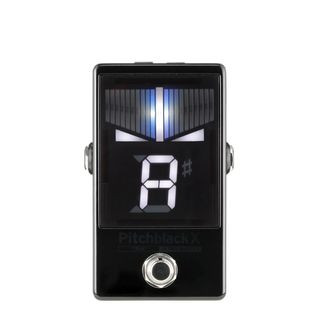 Best guitar tuners: Korg Pitchblack X
Best guitar tuners: Korg Pitchblack X
Best Guitar Tuner Pedal for Bassists: Korg Pitchblack X
Bassists, particularly those playing 5-string basses, often encounter tuners that struggle to register lower notes accurately. The Korg Pitchblack X pedal tuner eliminates these frustrations, offering reliable low-end tuning.
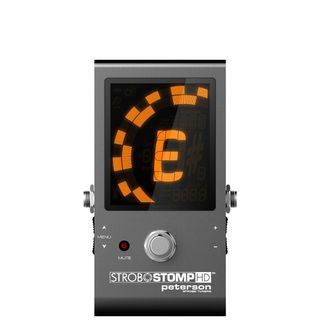 Best guitar tuners: Peterson StroboStomp HD
Best guitar tuners: Peterson StroboStomp HD
Best Guitar Tuner Pedal for Intonation Precision: Peterson StroboStomp HD
The Peterson StroboStomp HD has quickly become a preferred choice for professional guitarists and technicians. It combines a compact form factor with an extensive feature set and is recognized as one of the most accurate tuner pedals available, making it ideal for intonation work.
Discover Intonation Tuning Excellence
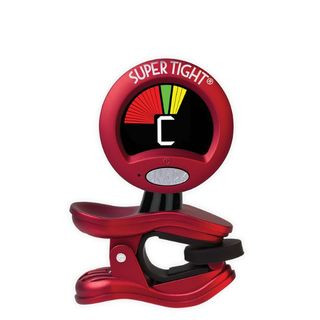 Best guitar tuners: Snark ST-2 Super Tight
Best guitar tuners: Snark ST-2 Super Tight
Best Beginner-Friendly Guitar Tuner: Snark ST-2 Super Tight
For guitarists just starting out, a clip-on tuner is often the most accessible option. The Snark ST-2 Super Tight offers incredible value for its price, delivering impressive accuracy in a user-friendly format.
Begin Your Tuning Journey Here
In-Depth Reviews of Top Guitar Tuner Pedals
Best Overall Guitar Tuner Pedal
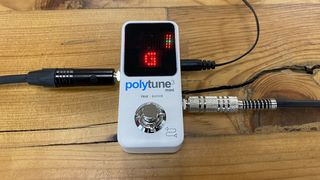 TC Electronic PolyTune 3 Mini tuner showcasing its polyphonic tuning display on a wooden surface
TC Electronic PolyTune 3 Mini tuner showcasing its polyphonic tuning display on a wooden surface
(Image credit: Future)
1. TC Electronic PolyTune 3 Mini Guitar Tuner
The ultimate polyphonic guitar tuner pedal in a space-saving mini format.
Read our expert review
Specifications:
- Type: Mini pedal tuner
- Tuning Range: A0-C8 (27.5Hz-4186Hz)
- Calibration Range: A4 = 435Hz-445Hz
- Accuracy: +/- 0.02 cents (strobe mode), 0.5 cents (chromatic mode)
- Modes: Polyphonic / chromatic / strobe
Reasons to Buy:
- Versatile bypass options: buffered and true bypass outputs
- Convenient always-on mode for constant monitoring
- Exceptional tuning accuracy and rapid response
Reasons to Avoid:
- Compact size may be challenging for users with larger feet
At a Glance:
✅ Ideal for guitarists embracing modern tuning technology: The polyphonic tuning feature of this pedal represents the cutting edge of guitar tuning, enabling you to view the tuning of all six strings at once for swift adjustments.
❌ Not recommended for players with larger shoe sizes: The pedal’s diminutive size might present usability issues for those with bigger feet or players who prefer wearing boots while playing.
The TC Electronic PolyTune 3 Mini stands out as a top-tier guitar tuner pedal, particularly if maximizing pedalboard real estate for creative effects is a priority. Our rigorous testing confirmed the Mini’s impressive capabilities and pinpoint tuning accuracy.
Polyphonic tuning, a hallmark of the PolyTune series, is seamlessly integrated into this mini pedal. The remarkably clear display, featuring 109 LEDs, effectively presents the potentially complex simultaneous tuning information of all six guitar strings.
For guitarists who explore techniques like slide guitar, fretless playing, or expressive string bends, the Mini’s practical always-on function serves as an invaluable real-time pitch guide. Furthermore, with switchable buffered and true bypass modes, the PolyTune Mini offers placement flexibility within any signal chain, accommodating various tonal preferences and setup configurations.
Read the comprehensive TC Electronic PolyTune 3 Mini review for an in-depth analysis.
Best Pedal Guitar Tuner for Stage Reliability
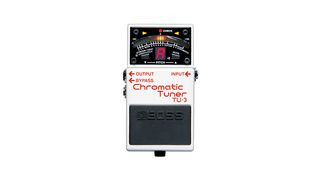 Boss TU-3 Guitar Tuner pedal, a standard for live performance, showcasing its robust build
Boss TU-3 Guitar Tuner pedal, a standard for live performance, showcasing its robust build
(Image credit: Press Material)
2. Boss TU-3 Guitar Tuner
An industry-standard pedal tuner renowned for its reliability and performance.
[Expert Review Available]
Specifications:
- Type: Pedal chromatic tuner
- Tuning Range: C0-C8 (16.35Hz-4,186Hz)
- Calibration Range: A4 = 436Hz-445Hz
- Accuracy: +/- 1 cent
- Modes: Chromatic / strobe
Reasons to Buy:
- Signature Boss build quality for exceptional durability
- Ultra-bright display for clear visibility in any lighting
- Superb tuning accuracy for reliable performance
Reasons to Avoid:
- Buffered bypass only, which may not suit all signal path preferences
At a Glance:
✅ The go-to pedal tuner for live performance: The Boss TU-3 is a ubiquitous presence on professional pedalboards, celebrated for its rugged construction and consistent, long-lasting performance in demanding live environments.
❌ Not ideal for players who strictly prefer true bypass: This pedal employs a buffered bypass, which inherently influences the guitar signal passing through, a factor that might be a concern for purists seeking absolute signal transparency when bypassed.
The Boss TU-3 represents an evolution of the best-selling, industry-standard TU-2, incorporating enhanced features such as drop tuning support, improved tuning accuracy, and ‘Accu-Pitch’ verification to visually confirm successful tuning. Adding to its stage-ready design is a brighter display screen, significantly improving visibility in direct sunlight – a boon for outdoor performances and busking scenarios.
Maintaining Boss’s reputation for rock-solid build quality, the TU-3 is built to withstand the rigors of touring and frequent use. While some newer pedals might offer a broader feature set for the price, the TU-3’s core strength lies in its unwavering reliability and efficient tuning capabilities, arguably the most critical aspects of a tuner pedal.
The TU-3 exclusively offers buffered bypass mode, a feature that polarizes players; some appreciate the signal conditioning benefits of a buffer, while others prioritize the uncolored signal path of true bypass. For those in the latter camp seeking a true-bypass Boss tuner, the TU-3W ‘Waza Craft’ edition is available, albeit at a significant price increase.
Best Clip-On Guitar Tuner for Versatility
 D'Addario NS Micro Universal clip-on tuner attached to a guitar headstock, showing its compact size
D'Addario NS Micro Universal clip-on tuner attached to a guitar headstock, showing its compact size
(Image credit: D’Addario)
3. D’Addario NS Micro Universal
A lightweight, adaptable clip-on tuner suitable for a wide range of instruments.
[Expert Review Available]
Specifications:
- Type: Clip-on tuner
- Tuning Range: Not Specified
- Calibration Range: A4 = 410-480Hz
- Accuracy: +/- 2 cents
- Modes: Not Applicable
Reasons to Buy:
- Exceptionally lightweight and unobtrusive
- Versatile clamp design for diverse headstock shapes
- Excellent screen viewing angles for optimal visibility
Reasons to Avoid:
- Small screen size may pose readability challenges for some users
At a Glance:
✅ Perfect for guitarists desiring a discreet clip-on tuner: The D’Addario NS Micro Universal’s compact size and minimal weight ensure it remains virtually unnoticed during playing, preserving the instrument’s aesthetics and balance.
❌ May not be suitable for users with visual sensitivity to small text: The tuner’s small display, while contributing to its discreet profile, could be challenging to read for individuals who have difficulty with small text at a distance.
The D’Addario NS Micro Universal stands out in the crowded clip-on tuner market as a top contender. Its blend of adaptable fit, lightweight construction, and sleek design establishes it as our preferred choice among the best clip-on guitar tuners available.
The innovative ratchet clip, coupled with a 360-degree swivel head, provides unparalleled flexibility, allowing it to securely attach to a wide array of guitar headstock designs. Its streamlined profile ensures it doesn’t interfere with playing, and its featherlight weight makes it feel practically imperceptible on the headstock.
The display is remarkably bright and offers four adjustable viewing angles, virtually eliminating any chance of losing sight of it, even on dimly lit stages. However, its small size is a factor to consider; users who struggle with reading small text from a distance might find the display challenging. Overall, we found it remarkably difficult to find any significant drawbacks to this highly practical and compact clip-on guitar tuner.
Best Guitar Tuner Pedal for Bass Guitar
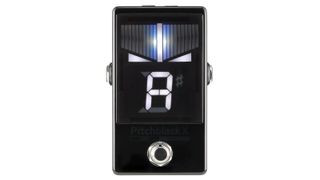 Korg Pitchblack X Pedal Tuner in operation, demonstrating its clear and bright display on a stage setting
Korg Pitchblack X Pedal Tuner in operation, demonstrating its clear and bright display on a stage setting
(Image credit: Korg)
4. Korg Pitchblack X Pedal Tuner
A highly accurate pedal tuner designed to excel with all types of guitars, especially basses.
Read our expert review
Specifications:
- Type: Pedal tuner
- Tuning Range: E0 – C8, 20.60Hz – 4,186Hz
- Calibration Range: A4 = 436Hz to 445Hz
- Accuracy: +/- 0.1 cent
- Modes: Regular, Strobe, Half-strobe, Mirror
Reasons to Buy:
- Integrated Ultra Buffer for preserving tone integrity
- Versatile with four distinct tuner display modes
- Bright mode enhances visibility in low-light conditions
Reasons to Avoid:
- Lacks polyphonic tuning functionality
At a Glance:
✅ Optimized for tuning bass guitars and extended-range instruments: The Pitchblack X delivers exceptional performance across all instruments, but it particularly shines in the lower frequency ranges, making it ideal for bassists and players using extended-range guitars.
❌ Not suitable for players seeking polyphonic tuning capabilities: Despite its extensive feature set, the absence of a polyphonic tuning mode might be a deterrent for guitarists who value the ability to tune all strings simultaneously.
The Korg Pitchblack X Pedal Tuner represents Korg’s latest iteration of their renowned stompbox tuner line, incorporating numerous enhancements while maintaining user-friendly operation. Even users unfamiliar with previous versions will find it immediately accessible.
A key highlight of the Pitchblack X is Korg’s newly engineered Ultra Buffer technology, offered alongside true bypass functionality. Users can select true bypass for pristine signal transparency in setups with short cable runs and minimal pedals. Conversely, engaging Ultra Buffer mode is recommended for passive pickups or rigs with longer cable lengths or multiple pedals, as it provides a subtle signal boost to mitigate potential tone loss, even when the Pitchblack X is bypassed.
Increased LED density enhances display visibility on brightly illuminated stages, and Korg’s ‘just-right tuning’ feature simplifies tuning feedback by causing both arrows to blink when perfect pitch is achieved. Boasting an impressive accuracy of +/- 0.1 cents, this tuner ensures precise and reliable tuning performance.
The Pitchblack X offers four distinct meter display modes: ‘Regular’ mode uses a stationary center LED and a moving LED to indicate pitch adjustments, with both arrows blinking upon reaching perfect tune. ‘Strobe’ and ‘half strobe’ modes use LED direction and speed to visualize pitch changes, requiring the LEDs to halt for accurate tuning. ‘Mirror’ mode employs converging LEDs from the left and right to guide tuning adjustments.
Power options for the Korg Pitchblack X Pedal Tuner include a 9V battery or an external power supply. For users seeking alternative form factors, the Pitchblack series also includes the rackmount 1U Pitchblack X Pro, the compact Pitchblack XS, and the ultra-mini Pitchblack X mini.
Explore the full Korg Pitchblack X review for a deeper dive into its features and performance.
Best Guitar Tuner Pedal for Intonation Accuracy
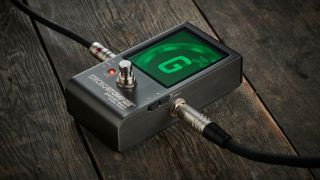 Peterson Strobostomp HD guitar tuner displayed on a wooden floor, highlighting its robust construction and clear screen
Peterson Strobostomp HD guitar tuner displayed on a wooden floor, highlighting its robust construction and clear screen
(Image credit: Future)
5. Peterson StroboStomp HD
Unparalleled tuning accuracy with a vast library of optimized presets for diverse tunings.
[Expert Review Available]
Specifications:
- Type: Pedal tuner
- Tuning Range: C0-A#8 (16.35Hz-7302Hz)
- Calibration Range: A4 = 390Hz-490Hz
- Accuracy: +/- 0.1 cent
- Modes: Single screen mode / 135 tuning presets
Reasons to Buy:
- Exceptionally clear screen, even in bright sunlight
- Extensive library of 135 ‘sweetened’ tuning presets
- User-programmable preset saving for custom tunings
Reasons to Avoid:
- Higher price point compared to standard tuner pedals
At a Glance:
✅ Ideal for users who prioritize tuning precision: The StroboStomp HD’s supreme accuracy makes it invaluable for meticulous guitar setups, particularly for intonation adjustments, ensuring optimal instrument performance and sound.
❌ May not be suitable for budget-conscious guitarists: Its advanced technology and comprehensive feature set contribute to a higher cost, potentially making it less accessible for players on a tighter budget.
Peterson strobe tuners have long been the gold standard for professionals demanding the highest level of tuning accuracy. In 2019, Peterson introduced the StroboStomp HD, positioned as their ‘ultimate pedal guitar tuner’.
The StroboStomp HD boasts a feature set exceeding most competitors, offering both true and buffered bypass modes alongside an impressive 135 ‘sweetened’ tunings. These specialized presets feature micro-adjusted reference pitches, optimized for various instrument types and alternate tunings. Sweetened tunings are particularly beneficial for addressing subtle intonation inconsistencies across the fretboard, ensuring chords sound harmonically richer across different neck positions.
A standout feature is the ability to save custom user presets, streamlining tuning changes during live performances. This level of tuning refinement is enabled by the StroboStomp HD’s exceptional 0.1 cent accuracy, catering to the most discerning ears and demanding tuning scenarios.
Best Beginner Guitar Tuner
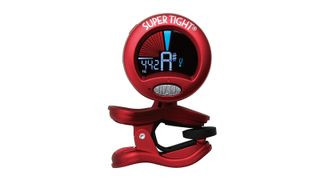 Snark ST-2 Super Tight Guitar Tuner clipped onto a guitar headstock, demonstrating its ease of use for beginners
Snark ST-2 Super Tight Guitar Tuner clipped onto a guitar headstock, demonstrating its ease of use for beginners
(Image credit: Snark)
6. Snark ST-2 Super Tight Guitar Tuner
A user-friendly tuner that effectively covers the essential tuning basics for beginners.
[Expert Review Available]
Specifications:
- Type: Clip-on chromatic tuner
- Tuning Range: Not Specified
- Calibration Range: A4 = 415Hz-466Hz
- Accuracy: Not Specified
- Modes: Microphone/vibration chromatic mode / metronome
Reasons to Buy:
- Versatile compatibility with guitar, bass, and other instruments
- Tunes via vibration sensor or microphone
- Integrated metronome for practice convenience
Reasons to Avoid:
- Accuracy and tuning range specifications not provided
At a Glance:
✅ Recommended as a first guitar tuner for beginners: The Snark ST-2 Super Tight’s ease of use and affordability make it an ideal starting point for any guitarist learning to tune their instrument.
❌ Less suitable for tuning in loud environments: Clip-on tuners, relying on vibration detection, may not provide optimal accuracy in noisy settings compared to direct input pedal tuners.
Given its remarkably low price, the Snark ST-2 Super Tight is a worthwhile addition to any guitarist’s toolkit, even as a backup kept in a gig bag. It’s particularly well-suited as the best guitar tuner for players on a budget or beginners taking their first steps in guitar playing. While more advanced and feature-rich tuners are available, the ST-2 focuses on providing essential tuning functionality in a straightforward package.
The ST-2’s attachment mechanism is robust, and its screen is easily adjustable for optimal viewing – a surprisingly crucial feature for clip-on tuners that need to accommodate various headstock and tuning machine configurations across six-string guitars, 12-strings, mandolins, and basses.
Performance-wise, the ST-2 offers rapid tracking. When set to vibration sensor mode, it performs reliably in most environments, except for extremely loud gig settings. The microphone mode is included for acoustic instruments but requires a quiet environment for accurate tuning. Considering its price point, the Snark ST-2 Super Tight delivers exceptional value, making it an excellent choice for beginner guitarists or anyone seeking an affordable and functional tuner.
More Guitar Tuner Pedal Options…
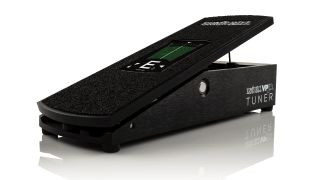 Ernie Ball VPJR Tuner pedal combining volume and tuning functions, showcased on a neutral background
Ernie Ball VPJR Tuner pedal combining volume and tuning functions, showcased on a neutral background
(Image credit: Ernie Ball)
7. Ernie Ball VPJR Tuner
A groundbreaking hybrid pedal combining volume control and tuning in one unit.
Read our expert review
Specifications:
- Type: Volume/Tuner Pedal
- Tuning Range: A0 to Bb6 (27.5Hz to 1864.88Hz)
- Calibration Range: A4 = 432Hz-447Hz
- Accuracy: +/- 0.1 cents (chromatic)
- Modes: Chromatic
Reasons to Buy:
- Innovative, modern user interface
- Highly visible, bold display
- Competitive pricing, considering its dual functionality
Reasons to Avoid:
- The tuner functionality itself is relatively basic
At a Glance:
✅ Ideal for pedalboards with limited space: The VPJR Tuner cleverly integrates a guitar tuner and a volume pedal, freeing up valuable pedalboard space for additional effects pedals.
❌ May not be suitable for budget-conscious buyers: Despite combining two pedals into one, the VPJR Tuner represents a significant investment.
The inclusion of a volume pedal in a guide focused on tuners might seem unconventional, but the Ernie Ball VPJR Tuner uniquely merges these essential functionalities. Ernie Ball’s expression pedal-based effects, including delays and overdrives, have gained widespread popularity, and they’ve now extended this design philosophy to the fundamental tuner pedal.
The VPJR is a 2-in-1 pedal, integrating a volume pedal with a digital chromatic tuner, displayed on a crystal-clear screen embedded within the pedal’s footboard. In ‘volume + tuning’ mode, moving the pedal to the heel-down position (zero signal) activates the tuner. As the pedal is engaged to increase volume, a volume level readout appears on the display. Ernie Ball also provides ‘volume only’ and ‘tuner only’ modes for simplified operation. These individual modes proved particularly useful during our testing, allowing for a focused approach when acclimating to the pedal’s dual functionality.
The tuner offers adjustable calibration across a range of pitches and can function as a master volume or gain control for your rig. Encased in a robust aluminum housing with a Kevlar cord for consistent foot sweep tension, the VPJR is built for durability. Its mono input jack accommodates both passive and active signals, with up to 18V of headroom, making it compatible with a wide array of guitars and basses.
Read the full Ernie Ball VPJR Tuner review for a comprehensive understanding of its innovative design and performance.
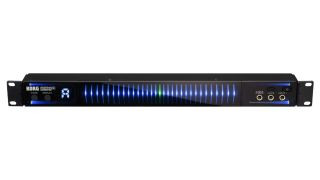 Korg Pitchblack X Pro rackmount tuner featuring a large, bright display, designed for rack-based guitar setups
Korg Pitchblack X Pro rackmount tuner featuring a large, bright display, designed for rack-based guitar setups
(Image credit: Korg)
8. Korg Pitchblack X Pro Rackmount Tuner
A flagship rack-mounted tuner offering exceptional visibility and accuracy for professional setups.
[Expert Review Available]
Specifications:
- Type: Rackmount tuner
- Tuning Range: E0 – C8, 20.60Hz – 4,186Hz
- Calibration Range: A4 = 436Hz to 445Hz
- Accuracy: +/- 0.1 cent
- Modes: Regular, Strobe, Half-strobe, Focus
Reasons to Buy:
- Extra-large, highly visible LED display
- Integrated Ultra Buffer for tone preservation
- Four selectable tuner display modes
Reasons to Avoid:
- Rackmount format may not be suitable for all setups
At a Glance:
✅ Designed for touring professionals needing a top-tier tuner: The Korg Pitchblack X Pro is engineered for professional guitarists who require a robust and highly visible rackmount tuning solution for demanding stage and studio environments.
❌ Overkill for smaller venues or home use: Unless you regularly perform at large venues or utilize a rack-based setup in your studio, a pedalboard-mounted tuner is generally more practical than a rackmount unit.
Imagine the core strengths of the Pitchblack X Pedal Tuner amplified within a 1U rackmount enclosure. The key advantages of the Pitchblack X Pro rackmount tuner are enhanced visibility and exceptional tuning accuracy. The expansive display dramatically improves the ease of making fine tuning adjustments, which is crucial given the tuner’s high degree of accuracy.
For guitarists primarily working in studio environments with existing rack setups, the Pitchblack X Pro is a natural fit. Its large display is easily visible across a studio room, significantly streamlining the tuning process.
In live performance contexts, the super-sized display also offers substantial benefits. With rack ears, mounting it onto a pedalboard is surprisingly straightforward, providing stage-ready visibility.
Korg has leveraged the larger form factor of the Pitchblack X Pro to incorporate additional features. Beyond the core features of the pedal version – true bypass, Ultra Buffer, four meter modes, and exceptional accuracy – the Pro model includes a cable checker and customizable LED hue options.
The Pitchblack X Pro offers a vibrant palette of display colors. Users can select from five color types, ranging from blue to red gradation, green to red gradation, or single-color gradations in cyan, green, or blue. This color customization allows for maximum display visibility or aesthetic matching with stage lighting, guitars, or personal style.
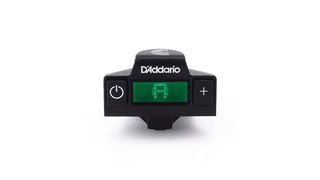 D’Addario NS Micro Soundhole Guitar Tuner discreetly mounted inside an acoustic guitar soundhole
D’Addario NS Micro Soundhole Guitar Tuner discreetly mounted inside an acoustic guitar soundhole
(Image credit: Press Material)
9. D’Addario NS Micro Soundhole Guitar Tuner
The ideal guitar tuner for acoustic players seeking a discreet and unobtrusive device.
[Expert Review Available]
Specifications:
- Type: Soundhole tuner
- Calibration Range: A4 = 435Hz-445Hz
- Accuracy: +/- 0.3 cents
- Modes: Automatic / manual
Reasons to Buy:
- Virtually invisible to audiences when mounted
- Fast and responsive tuning detection
- Non-marking attachment ensures instrument safety
Reasons to Avoid:
- More accurate tuner options are available
- Designed exclusively for acoustic instruments
At a Glance:
✅ Specifically designed for discreet acoustic guitar tuning: This soundhole-mounted tuner is perfect for acoustic guitarists who prioritize maintaining the natural aesthetics of their instrument, as it clips within the soundhole, remaining largely unseen.
❌ Not compatible with electric guitars or other non-acoustic instruments: Its soundhole-specific design limits its use to acoustic instruments, making it unsuitable for electric guitar players.
Designed for acoustic guitars, basses, and ukuleles, D’Addario’s soundhole-mounted tuner is a compact and user-friendly device, featuring a bright, multi-color display for easy viewing. Its discreet placement inside the acoustic guitar’s soundhole ensures it doesn’t detract from the instrument’s visual appeal. A non-marking attachment mechanism allows for worry-free installation without damaging the instrument’s finish.
The NS Micro Soundhole Tuner operates by sensing vibrations directly from the guitar’s soundboard, providing significantly more accurate tuning compared to older microphone-based tuners that are prone to picking up ambient noise. While more accurate and pricier tuners exist, the NS Micro’s combination of ease of use, discreet form factor, and reliable performance makes it a compelling option for acoustic players.
This tuner is specifically designed for acoustic instruments. However, for acoustic guitarists seeking a small, highly practical tuner that can remain conveniently in their gig bag, the NS Micro Soundhole Tuner is an excellent choice, particularly for those who wish to maintain the pristine look of their acoustic guitar.
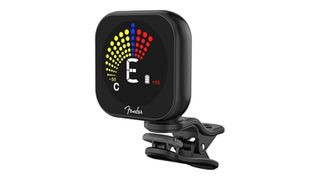 Fender Flash 2.0 clip-on tuner showcasing its color LCD screen, attached to a guitar headstock
Fender Flash 2.0 clip-on tuner showcasing its color LCD screen, attached to a guitar headstock
(Image credit: Fender)
10. Fender Flash 2.0
A long-lasting, rechargeable clip-on tuner offering extended performance and versatile features.
[Expert Review Available]
Specifications:
- Type: Clip-on headstock tuner
- Tuning Range: A0, 440Hz calibration
- Calibration Range: A4 = 440Hz
- Accuracy: +/- 1 cent*
- Modes: Guitar, Bass, Ukulele, Violin, and Chromatic tuning modes. Alternate tuning modes: Open G, D, E, ♭ and ♭♭
Reasons to Buy:
- Rechargeable battery with impressive battery life
- Wide array of tuning modes, including alternate tunings
- Color LCD screen enhances visibility
Reasons to Avoid:
- Fixed A = 440Hz calibration, limiting flexibility for some users
At a Glance:
✅ Ideal for guitarists needing a reliable, long-lasting clip-on tuner: The Fender Flash 2.0’s rechargeable battery provides dependable performance, eliminating the worry of battery failures during critical moments, unlike traditional battery-powered tuners.
❌ Not suitable for players requiring adjustable calibration ranges: This tuner is fixed at A=440Hz, which may not meet the needs of musicians who need to tune to different calibration standards.
The dreaded scenario of a clip-on tuner failing mid-performance due to battery depletion is a real concern for gigging musicians. The Fender Flash Tuner effectively addresses this with its rechargeable design, offering both peace of mind and environmental consciousness. A full charge via the included USB cable provides up to 20 hours of continuous use, with an auto shut-off feature extending battery life even further in practice.
For an affordable clip-on tuner, the Flash 2.0 is surprisingly feature-rich. Its clip offers dual 360° swivels and a 120° hinge, ensuring the color LED screen can always be positioned for optimal viewing.
It includes modes for Guitar, Bass, Ukulele, Violin, and Chromatic tuning, along with alternate tuning presets for half step flat, full step flat, and open G, D, and E tunings. A particularly useful feature is the prominent battery indicator on the screen, preventing unexpected power loss during crucial moments.
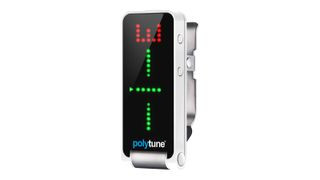 TC Electronic PolyTune Clip Guitar Tuner attached to a guitar headstock, highlighting its compact and discreet design
TC Electronic PolyTune Clip Guitar Tuner attached to a guitar headstock, highlighting its compact and discreet design
(Image credit: TC Electronic)
11. TC Electronic PolyTune Clip
Polyphonic tuning in a clip-on format, perfect for acoustic players seeking advanced features.
[Expert Review Available]
Specifications:
- Type: Clip-on tuner
- Tuning Range: A0-C8 (27.5Hz-4186Hz)
- Calibration Range: A4 = 435Hz-445Hz
- Accuracy: +/- 0.02 cents (strobe mode), 0.5 cents (chromatic mode)
- Modes: Polyphonic / chromatic / strobe
Reasons to Buy:
- Exceptional tuning accuracy, especially in strobe mode
- Compact and discreet design
- Unique polyphonic tuning functionality in a clip-on
Reasons to Avoid:
- Higher price point compared to basic clip-on tuners
At a Glance:
✅ Recommended for players needing a highly accurate clip-on tuner: The PolyTune Clip combines polyphonic tuning with superb accuracy, making it an excellent clip-on option for players who demand precise tuning.
❌ May not be the best choice for budget-constrained buyers: While offering advanced features, its higher cost compared to simpler clip-on tuners might be a consideration for those on a tighter budget.
Despite its 2015 release, the TC Electronic PolyTune Clip remains a top-tier clip-on tuner, boasting impressive accuracy: +/- 0.02 cents in strobe mode (one 5,000th of a semitone!) and 0.5 cents in chromatic mode.
As its name suggests, the PolyTune Clip features polyphonic tuning, alongside a traditional single-note ‘needle’ mode for users who prefer a more conventional display. While marketed for six-string guitars, the PolyTune Clip also supports bass guitars, albeit exclusively in needle mode. It remains a stylish and highly functional tuner regardless of instrument.
While not the cheapest clip-on tuner, our testing confirms that the PolyTune Clip outperforms most other clip-on tuners on the market. For users prioritizing a small, convenient, and highly accurate tuner, the PolyTune Clip is a standout choice.
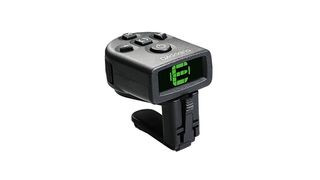 D’Addario Micro Headstock Guitar Tuner, highlighting its small footprint and discreet placement on a guitar headstock
D’Addario Micro Headstock Guitar Tuner, highlighting its small footprint and discreet placement on a guitar headstock
(Image credit: Press Material)
12. D’Addario Micro Headstock Tuner
A user-friendly, ultra-compact headstock tuner offering exceptional value and discreetness.
[Expert Review Available]
Specifications:
- Type: Headstock tuner
- Calibration Range: A4 = 410Hz-480Hz
- Accuracy: +/- 0.3 cents
- Modes: Chromatic / metronome
Reasons to Buy:
- Exceptionally small and compact profile
- Lightweight design minimizes added headstock weight
- Excellent value for its price
Reasons to Avoid:
- Display size could be improved for better visibility
At a Glance:
✅ Ideal for players seeking a low-profile headstock tuner: The Micro Headstock Tuner, one of D’Addario’s compact tuner offerings, is designed to be as unobtrusive as possible, minimizing its visual footprint on the instrument.
❌ May not be suitable for users needing a large, easily readable display: The tuner’s small display, while contributing to its low profile, might be challenging for those who require larger text for comfortable viewing at a distance.
Similar to D’Addario’s soundhole-mounted tuner, the Micro Headstock Tuner prioritizes a small and unobtrusive design. Its lightweight construction is beneficial for maintaining the instrument’s balance. For guitarists who prefer clip-on tuners but are sensitive to added weight on the headstock, this tuner is an excellent solution.
With an accuracy of +/- 0.3 cents, the Micro Headstock Tuner is among the more accurate models in our best guitar tuner pedals guide, particularly impressive given its budget-friendly price. It’s also designed to remain on the guitar during transport, minimizing the risk of forgetting your tuner before a performance.
While the display is a straightforward chromatic layout, lacking the strobe-style displays of pricier models, its strength lies in wallet-friendly simplicity and functionality. The Micro Headstock Tuner’s exceptionally small profile makes it a top choice for guitarists who prioritize maintaining the aesthetic and balance of their guitars.
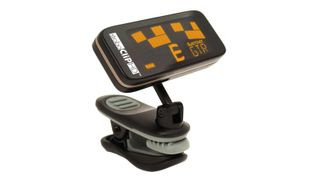 Peterson StroboClip HD clip-on tuner showcasing its strobe display, attached to a guitar headstock
Peterson StroboClip HD clip-on tuner showcasing its strobe display, attached to a guitar headstock
(Image credit: Peterson)
13. Peterson StroboClip HD
A powerful clip-on strobe tuner with advanced sweetened tunings for ultimate precision.
[Expert Review Available]
Specifications:
- Type: Clip-on headstock tuner
- Tuning Range: C0 – B6, frequency response 16Hz – 1,975Hz
- Calibration Range: A = 390Hz to 490Hz
- Accuracy: +/- 0.1 cent*
- Modes: 50 ‘sweetened’ tunings
Reasons to Buy:
- Unrivaled tuning accuracy
- Highly visible display in all lighting conditions
- Extensive library of sweetened tunings
Reasons to Avoid:
- Strobe display may require a learning curve for new users
- Higher cost compared to standard clip-on tuners
At a Glance:
✅ Ideal for players needing a feature-rich, high-performance clip-on tuner: The StroboClip HD combines exceptional accuracy with sweetened tunings, making it one of the best clip-on tuners available for discerning players.
❌ May not be suitable for budget-conscious musicians: Its advanced features and precision come at a premium, making it one of the most expensive clip-on tuners on the market.
As the name implies, the StroboClip HD delivers the accuracy of a strobe pedal tuner in a compact clip-on format, ready to attach to a guitar headstock or various other instruments.
Accuracy is an astonishing 0.01 cent. Tuning is achieved by adjusting the guitar’s tuning pegs until the animated strobe disk on the display appears to stop spinning. Peterson asserts that this strobe tuning method is exceptionally precise, surpassing the accuracy of animated arrows or flashing lights found in conventional tuners.
While accurate tuning is always beneficial, the StroboClip HD’s precision unlocks the ability to experiment with ‘sweetened tunings’. It includes a library of 50 sweetened tunings for a wide array of instruments, from banjos to brass, including guitars.
Despite its small size, the StroboClip HD’s LCD screen remains highly visible in dimly lit stage environments and even in direct sunlight. Bassists will appreciate its ability to accurately recognize low E strings, a capability not always found in clip-on tuners.
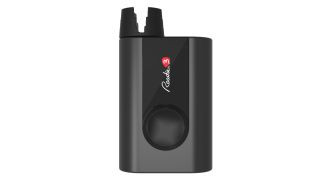 Band Industries Roadie 3 Guitar Tuner, a robotic tuner, showcased with a guitar, demonstrating its automatic tuning capabilities
Band Industries Roadie 3 Guitar Tuner, a robotic tuner, showcased with a guitar, demonstrating its automatic tuning capabilities
(Image credit: Band Industries)
14. Roadie 3 Guitar Tuner
An innovative automatic, motorized tuner that tunes your guitar for you, simplifying string changes and alternate tunings.
Read our expert review
Specifications:
- Type: Motorized automatic tuner
- Accuracy: +/- 2 cents
- Modes: 40 factory tuning presets + 40 user presets
Reasons to Buy:
- Automates the tuning process, eliminating manual tuning
- Simplifies and speeds up string replacement
- Versatile compatibility with guitars, banjos, and ukuleles
Reasons to Avoid:
- Separate bass model required for bass guitars
At a Glance:
✅ Ideal for guitarists seeking automated tuning assistance: The Roadie 3 automates string winding, eliminating the tedious manual process of turning tuning pegs, especially beneficial during string changes.
❌ Not compatible with bass guitars in this specific model: Bassists will need to purchase a dedicated Roadie Bass model to accommodate the larger tuning machines of bass guitars.
While the market is saturated with tuner pedals, automatic motorized tuners like the Roadie 3 are less common. Using its vibration sensor, the Roadie 3 detects string pitch and automatically adjusts it to a selected note. Simply attach it to a tuning peg, and the tuner handles the winding, reaching speeds up to 120rpm.
The Roadie 3 also features an integrated metronome for rhythm practice and an improved peg connector for broader instrument compatibility. It works with most guitars and can also tune banjos, acoustic guitars, and ukuleles. While entrusting tuning to a machine might seem unusual, its performance is remarkably effective.
The Roadie 3 includes over 100 built-in tuning presets, including alternate tunings like DADGAD and capo tunings, accessible via the onboard LED screen. The free Roadie 3 app expands editing capabilities and custom tuning options.
Read the full Roadie 3 Automatic Guitar Tuner review for a detailed exploration of its automated tuning capabilities.
Buying Advice: Choosing the Right Guitar Tuner Pedal
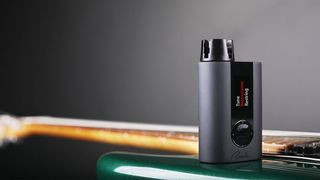 Roadie 3 guitar tuner resting on a green electric guitar, illustrating its ease of use and portability
Roadie 3 guitar tuner resting on a green electric guitar, illustrating its ease of use and portability
(Image credit: Band Industries)
What are the Different Types of Guitar Tuners?
Guitar tuners primarily fall into three main categories. Beyond marketing claims, the core distinctions boil down to user preference and specific needs:
Chromatic Tuners: These tuners compare the incoming signal to the 12 notes of the chromatic scale. They are designed to recognize these specific notes and tune one note at a time. For the majority of guitarists, these limitations are rarely an issue.
Polyphonic Tuners: Similar to polyphonic pitch-shifters or synthesizers, ‘polyphonic’ in tuners signifies the ability to process multiple notes simultaneously. The challenge lies in effectively displaying this multi-string information to the user. However, polyphonic tuners are incredibly useful in live settings, allowing for quick strumming of all strings to assess overall tuning at a glance.
Strobe Tuners: Strobe tuners offer the highest level of precision and versatility. Unlike chromatic tuners, strobe tuners can be calibrated to custom frequencies and temperaments. This is particularly beneficial for musicians playing music outside standard Western scales or experimenting with alternative pitch standards, such as 432Hz instead of 440Hz. While often considered esoteric, the 432Hz standard was notably used in Soundgarden’s hit “Black Hole Sun” and is favored by numerous artists. Strobe tuners typically represent the most specialized and expensive tuner type.
Generally, chromatic tuners are a reliable choice for most guitarists working within standard Western scales, although personal preference plays a significant role in tuner selection.
Pedal Tuner vs. Clip-On vs. Microphone Tuner: Which is Best for Your Needs?
Form factor also dictates tuner types, with three primary categories. While some models are tailored for bass or ukulele, most tuners are versatile enough for use across different stringed instruments.
Microphone Tuners (Free – $10/£10): These tuners, often the most affordable, utilize a microphone for input, making them adaptable to tuning various stringed instruments. However, their microphone-based input makes them susceptible to interference from background noise. Historically, these were dedicated hardware devices, but nowadays, they are commonly available as smartphone apps.
Clip-On Tuners ($5-30/£5-30): Clip-on guitar tuners attach to the instrument’s headstock and detect pitch via vibrations. This method is energy-efficient and allows for a compact design. Modern clip-on tuners, such as the TC Electronic PolyTune Clip and Unitune, have achieved accuracy levels suitable even for professional studio use, primarily due to their convenience. They can be kept readily accessible or distributed around a studio for quick tuning adjustments during creative sessions.
Stompbox Tuners ($50+/£50+): Stompbox tuners, or pedal tuners, use a standard 1/4″ jack input, primarily designed for electric guitars, basses, and ukuleles, or acoustic instruments equipped with pickups. In a signal chain, a tuner pedal is typically placed first, as it can also function as a mute switch when engaged. However, due to the buffered bypass in many tuner pedals, some players prefer to place them outside the main audio path. Effect pedals with dedicated tuner outputs allow for signal splitting mid-chain, enabling the tuner to remain ‘always on,’ which is a common preference for continuous monitoring.
Rackmount Tuners ($100+/£100+): Rackmount tuners, typically found in professional touring rigs, offer the advantage of a larger display area, providing a more detailed and accurate view of tuning. However, their size makes them less practical for standard pedalboards. Rackmount tuners are ideal for guitarists with existing rack setups or those seeking ultimate tuning accuracy in studio environments.
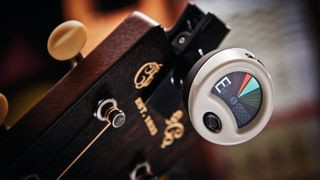 Snark clip-on guitar tuner attached to the headstock of a Martin acoustic guitar, demonstrating a typical clip-on tuner setup
Snark clip-on guitar tuner attached to the headstock of a Martin acoustic guitar, demonstrating a typical clip-on tuner setup
(Image credit: Future)
Are Guitar Tuner Apps Accurate Enough?
Increasingly, new guitarists are opting for microphone-based tuner apps instead of dedicated hardware tuners. While convenient for quick acoustic tuning, they are generally insufficient for serious practice or performance. Background noise and ergonomic limitations often hinder accurate input capture. In contrast, a dedicated ‘always-on’ tuner pedal offers far greater reliability when needed.
Google recently launched its browser-based Google Tuner. While it requires a strong string attack for note registration, it performed consistently in our tests against the Korg chromatic tuner and TC Electronic’s PolyTune app. The interface is user-friendly, making Google Tuner a useful backup if a hardware tuner is forgotten or runs out of batteries. However, we still strongly recommend owning a dedicated hardware tuner for dependable performance.
Understanding Sweetened Tunings
The high accuracy of some strobe tuners enables the use of sweetened tunings. Most modern Western scales use equal temperament, dividing the octave into 12 equal notes. While mathematically convenient, it’s a compromise and not perfectly harmonically accurate.
Similarly, on fretted instruments like guitars, some fretted notes can be slightly out of tune even with proper setup and intonation. Sweetened tunings attempt to correct these minor discrepancies by slightly adjusting intervals, making certain chords and dyads sound ‘sweeter’ in specific positions on the neck.
However, sweetened tunings involve trade-offs. While some chords in certain neck regions may sound improved, others might sound less optimal. Tuner developers address this by providing numerous sweetened tunings tailored to different instruments, open tunings, and musical genres, allowing users to select tunings best suited to their playing context.
What Does A440 Mean in Guitar Tuning?
It may seem surprising, but a standardized pitch reference in Western music is a relatively recent development. Historically, the pitch of notes varied geographically. For example, the note C in France could differ in pitch from the same note C in Germany. This is reflected in slight length variations between antique flutes from different regions. Even within countries, tuning standards varied between cities, posing challenges for traveling musicians.
In the late 1800s, French tuning standards set A below middle C at 435Hz, while English standards were significantly higher at 452Hz. It was only in 1939 that an international committee agreed to 440Hz as concert pitch, officially ratified by the International Organization for Standardization in 1955.
Does A440 matter for guitarists? For most, a tuner fixed at A=440Hz is perfectly adequate. However, musicians playing classical pieces within ensembles might encounter preferences for older, historically informed tuning standards.
The growing popularity of meditation and wellness music has also increased the use of A=432Hz. Proponents believe 432Hz is more harmonically aligned with the universe. Many singing bowls and chimes are tuned to 432Hz, making accurate tuning to this standard necessary for guitarists accompanying these instruments.
How We Test Guitar Tuner Pedals
While guitar tuners are fundamentally simple devices, our review process is thorough and rigorous. A tuner must be robust, reliable, and user-friendly to earn our recommendation.
Upon receiving a tuner for review, we begin by assessing its build quality and feature set. For clip-on tuners, we evaluate headstock compatibility across various instruments, display flexibility, and potential weight impact on the headstock.
For pedal tuners, we examine their overall build quality and perceived durability underfoot. We note any additional features like bypass options or buffered switching and check power requirements (battery or external supply).
After initial assessment, we power on or plug in the tuner and begin practical testing. For pedal tuners, we prioritize display brightness and tuning sensitivity for fine adjustments. Display clarity is crucial for readability and detailed tuning feedback. Clip-on tuners undergo similar evaluation, considering display visibility despite their smaller size.
Testing clip-on tuners in noisy environments is essential. We test them at live shows or during band practices to assess performance against PA systems and bass amplifiers. Pedal tuners are evaluated for switch responsiveness and ease of integration into pedalboard setups.
For a deeper understanding of our testing methodology and review policies, please refer to our how we test guidelines, which detail our comprehensive product evaluation processes.

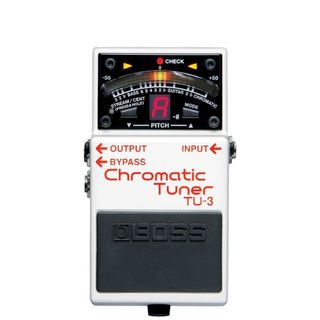 Best guitar tuners: Boss TU-3
Best guitar tuners: Boss TU-3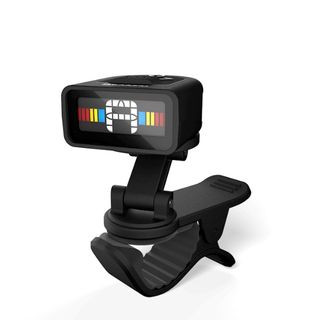 Best guitar tuners: D
Best guitar tuners: D